
PoreLab UiO together with the Science Library in Oslo are organizing a talk from Professor Albert-László Barabási on March 22nd at 14:00.
It will be streamed at the Science Library’s youtube channel (https://www.youtube.com/@realfagsbiblioteket/streams)
Web page: https://www.ub.uio.no/english/courses-events/events/mednat/ureal/2023/230322physicsatthelibrary.html
Facebook event: https://fb.me/e/10fmQxVL6
Albert-László Barabási
Network Science Institute and Department of Physics, Northeastern University Division of Network Medicine, Harvard University Department of Network and Data Science, Central European University.
Just about every field of research is confronted with networks. Metabolic and genetic networks describe how proteins, substrates and genes interact in a cell; social networks quantify the interactions between people in the society; the Internet is a complex web of computers; ecological systems are best described as a web of species. In all these fields the detailed knowledge of the components is insufficient to describe the whole system.
Network science has led to the realization that despite the diversity of these systems, the underlying networks emerge and evolve following simple but generic laws, that are best unveiled using the toolset of statistical physics. As a result, today network science is an indispensable tool from physics to medicine, and its applications, ranging from epidemic control during COVID to medical diagnostic tools affecting patients, directly impact our life.
Professor Albert-László Barabási is a network scientist, fascinated with a wide range of topics, from unveiling the structure of the brain to treating diseases using network medicine, from the emergence of success in art to how does science really works. His work has helped unveil the hidden order behind various complex systems using the quantitative tools of network science, a research field that he pioneered, and lead to the discovery of scale-free networks, helping explain the emergence of many natural, technological and social networks.
